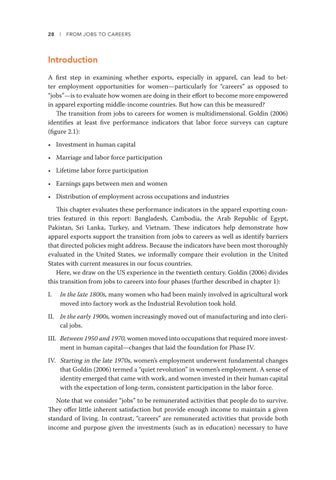28
l
FROM JOBS TO CAREERS
Introduction A first step in examining whether exports, especially in apparel, can lead to better employment opportunities for women—particularly for “careers” as opposed to “jobs”—is to evaluate how women are doing in their effort to become more empowered in apparel exporting middle-income countries. But how can this be measured? The transition from jobs to careers for women is multidimensional. Goldin (2006) identifies at least five performance indicators that labor force surveys can capture (figure 2.1): • Investment in human capital • Marriage and labor force participation • Lifetime labor force participation • Earnings gaps between men and women • Distribution of employment across occupations and industries This chapter evaluates these performance indicators in the apparel exporting countries featured in this report: Bangladesh, Cambodia, the Arab Republic of Egypt, Pakistan, Sri Lanka, Turkey, and Vietnam. These indicators help demonstrate how apparel exports support the transition from jobs to careers as well as identify barriers that directed policies might address. Because the indicators have been most thoroughly evaluated in the United States, we informally compare their evolution in the United States with current measures in our focus countries. Here, we draw on the US experience in the twentieth century. Goldin (2006) divides this transition from jobs to careers into four phases (further described in chapter 1): I.
In the late 1800s, many women who had been mainly involved in agricultural work moved into factory work as the Industrial Revolution took hold.
II. In the early 1900s, women increasingly moved out of manufacturing and into clerical jobs. III. Between 1950 and 1970, women moved into occupations that required more investment in human capital—changes that laid the foundation for Phase IV. IV. Starting in the late 1970s, women’s employment underwent fundamental changes that Goldin (2006) termed a “quiet revolution” in women’s employment. A sense of identity emerged that came with work, and women invested in their human capital with the expectation of long-term, consistent participation in the labor force. Note that we consider “jobs” to be remunerated activities that people do to survive. They offer little inherent satisfaction but provide enough income to maintain a given standard of living. In contrast, “careers” are remunerated activities that provide both income and purpose given the investments (such as in education) necessary to have


